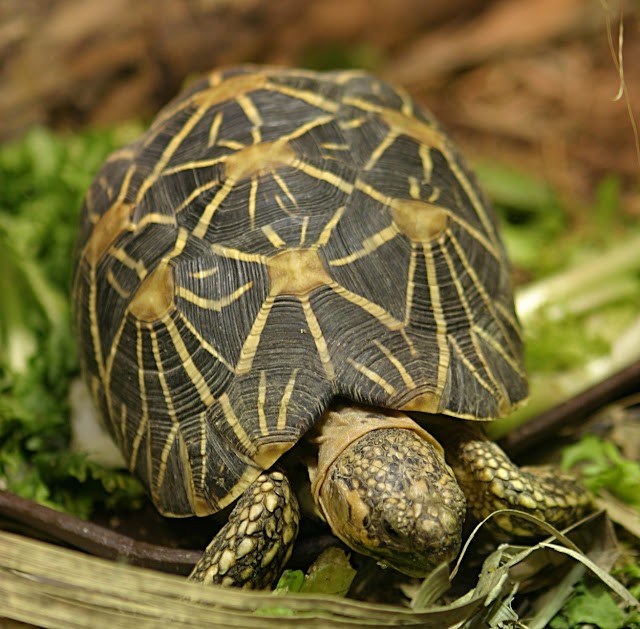Pet Tortoises and Freshwater Turtles of India
Three-quarters of Asia’s 90 species of tortoise and freshwater turtle are now considered threatened. Worldwide, the danger is approaching similar proportions. Our scientists and partners with the IUCN-World Conservation Union estimate that at least 40 percent of all tortoise and freshwater turtle species are threatened with extinction. While habitat loss is partly to blame, the single greatest threat is the commercial collection of adult turtles. Demand for turtle meat and shells, mostly bound for Asian markets, has fueled turtle poaching on every continent.
Turtles
Turtles are reptiles of the order Testudines (the crown group of the superorder Chelonia), characterised by a special bony orcartilaginous shell developed from their ribs that acts as a shield. “Turtle” may either refer to the Testudines as a whole, or to particular Testudines which make up a form taxon that is not monophyletic.
The order Testudines includes both extant (living) and extinct species. The earliest known turtles date from 215 million years ago,making turtles one of the oldest reptile groups and a more ancient group than lizards, snakes and crocodiles. Of the many species alive today, some are highly endangered.
Like other reptiles, turtles are ectotherms—their internal temperature varies according to the ambient environment, commonly called cold-blooded. However, leatherback sea turtles have noticeably higher body temperature than surrounding water because of their high metabolic rate.
Like other amniotes (reptiles, dinosaurs, birds, and mammals), they breathe air and do not lay eggs underwater, although many species live in or around water. The largest turtles are aquatic.
RED-CROWNED ROOF TURTLE
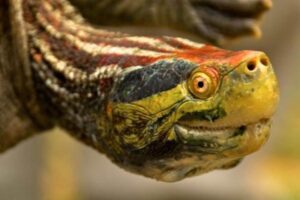
kachuga can weigh up to 25 kilograms (55 lb) pounds and have shells as long as 56 centimeters (22 in) 22 inches. Males reach only half the length of females. At the end of the rainy season, the heads and necks of male turtles develop a brilliant courtship coloration of red, yellow, white, and blue, with 6 distinctive bright red stripes on top of the head.Historically at home in the great rivers of northern India, female red-crowned roof turtles (Kachuga kachuga) can weigh up to 55 pounds and have shells as long as 22 inches. Males only reach half the length of females. At the end of the rainy season, the faces and necks of male turtles develop a spectacular courtship coloration of red, yellow, white, and blue to win over the females. Where young roof turtles go to feed, grow, and hide from predators remains a mystery. Scientists are trying to solve it by studying this species in India’s Chambal River, its last stronghold.
ROOFED TURTLE
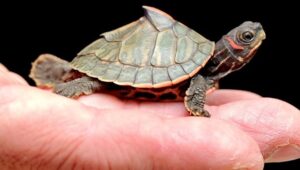
The Indian roofed turtle(Pangshura tecta), is a species of the Pangshura family of turtle found in the major rivers of South Asia. Carapace olive, that of young with some black spots, especially on the posterior edge of the first three vertebrals; an orange vertebral band and a narrow yellow margin; carapace more uniform in the adult; plastron orange or red, with black spots, or brown with a yellowish anterior and lateral border to each shield, in one specimen uniform yellow. Head blackish; jaws and sides of crown orange; neck with numerous yellow lines on a blackish ground; limbs dark olive, spotted with yellow. Length of shell up to nearly 9 inches.
This is a quiet-water turtle, occurring in quiet streams, canals, oxbows, ponds, and man-made water tanks. It also occurs in brackish coastal waters. A soft bottom and abundant aquatic vegetation are preferred conditions. It loves basking in the early morning sun.
SOFT SHELL TURTLE

The Ganges softshell turtle Aspideretes gangeticus is a species of softshell turtle found in South Asia in rivers such as the Ganges, Indus and Mahanadi.Costal plates eight pairs, the last well developed and in contact throughout on the median line; two neurals between the first pair of costals; plates coarsely pitted and vermieulate. Epiplastra narrowly separated from each other in front of the ontoplastron, which forms an obtuse or a right angle; plastral callosities very large, hyo-hypoplastral, xiphiplastral, and, in old specimens, ento-plastral. Dorsal skin of young with longitudinal ridges of small tubercles. Head moderate; snout (on the skull) about as long as the diameter of the orbit.
Peacock Soft Shell turtle
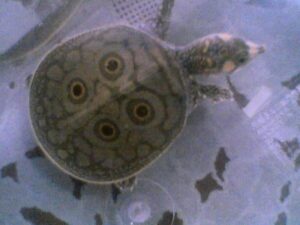
Indian peacock softshell turtle Aspideretes hurum is a species of turtle found in Nepal, India, Bangladesh (in the Brahmaputra and Ganges rivers), Pakistan (fide Khan, pers. comm.). Type locality: “India”; restricted by M A Smith to “Fatehgarh, Ganges,” India; restricted by Webb (1980: 71), to “Barrackpore (about 23 kilometers north Calcutta), West Bengal, India
Indian narrow-headed softshell turtle Chitra indica is a species of turtle found in the major rivers of Pakistan and India.
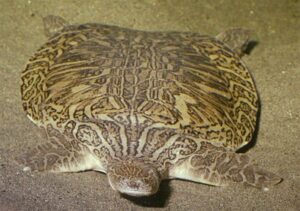
Diagnostic characters
- Overall color: olive to deep olive-green;
- Very complex midline (vertebral) carapacialpattern;
- Midline (vertebral) carapacial stripe present;
- Complex radiating costal stripes;
- Paramedian neck stripes forming a bell-like pattern on anterior carapace absent;
- Neck stripes do not form a continuous light rim around carapace;
- No distinct pair of neck stripes;
- Dark speckling on “light” (head and neck) stripes;
- Anterior neck “V” divergence point on neck;
- 3-4 forelimb lamellae;
- No peri-orbital X pattern;
- No distinct peri-orbital ocelli;
- No distinct naso-orbital triangular “figure”;
- Few, if any, black dots present on chin pattern.
Type locality: “India, fl. Ganges, Penang”; restricted by Smith (1931:162) to “Fatehgarh, Ganges,” India = “India: Ganges; Futtaghur” (Gray 1864: 92)
Tortoises
Tortoises are a family of land-dwelling reptiles of the order of turtles (Testudines). Like their marine cousins, the sea turtles, tortoises are shielded from predators by a shell. The top part of the shell is the carapace, the underside is the plastron, and the two are connected by the bridge. The tortoise has both an endoskeleton and an exoskeleton. Tortoises can vary in size from a few centimeters to two meters. Tortoises are usually diurnal animals with tendencies to be crepuscular depending on the ambient temperatures. They are generally reclusive animals.
Indian star tortoise
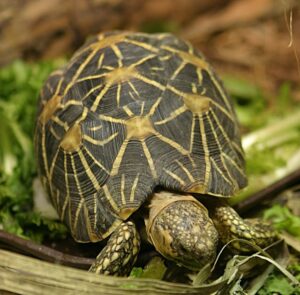
The Indian star tortoise (Geochelone elegans) is a species of tortoise found in dry areas and scrub forest in India and Sri Lanka. This species is quite popular in the exotic pet trade.
The shape of this creature is presumed to be specially adapted to naturally assist it to return to a stable stance after it has been turned over. Mathematicians Gábor Domokos of the Budapest University of Technology and Economics and Péter Várkonyi of Princeton University designed a homogenous object called Gömböc that has exactly one unstable balance point and exactly one stable balance point. Just as a bottom-weighted (non-homogenous weight distribution) sphere would always return to the same upright position, they found it was possible to construct a shape that behaves the same way. After that, they noted the similarity to the Indian Star Turtle and subsequently tested 30 turtles by turning them upside down. They found that many of them were self-righting.
Elongated Tortoise
Elongated Tortoise (Indotestudo elongata) is a species of tortoise found in Southeast Asia and parts of South Asia.
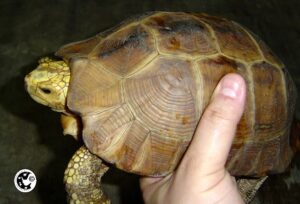
Typically, Indotestudo elongata are around 30 cm (12 inches) long and 3.5 kg (7 pounds) as an adult. Females tend to be wider than males and more rounded. Males also have a tail that is much larger than that of the female. The males have a concave plastron while the plastron of a female is flat. Additionally, the female’s posterior claws are markedly longer and more curved than those of the male. It is believed that this is to facilitate nest building.
The species is found in Nepal, Bangladesh, India (Jalpaiguri, East Bengal, and Singhbhum in Bihar), Burma (or Myanmar), Laos, Thailand (incl. Phuket), Cambodia, Vietnam, W Malaysia, S China.
Travancore tortoise
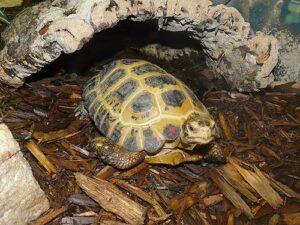
The Travancore tortoise (Indotestudo travancorica) is a large forest tortoise growing up to 330 millimetres (13 in) in length. It primarily feeds on grasses and herbs. It also feeds on molluscs, insects, animal carcass, fungi and fruits. It occurs in hill forests at 450–850 m elevation. Males combat by ramming their shell during their breeding season between November and March. It makes a shallow nest in the ground and lay 1-5 eggs. Hatchlings are 55–60 mm in size. The tortoise is hunted and it is threatened due to forest fires, habitat destruction and fragmentation.
- Status: IUCN Red list – Vulnerable; Indian Wildlife (Protection) Act: Schedule IV.
- Distribution: restricted to the Western Ghats, in the states of Kerala, Karnatakaand Tamil Nadu (India).
Brown Tortoise or Asian Forest Tortoise
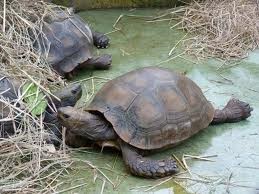
Asian forest tortoise (Manouria emys), also known as Asian brown tortoise, is a species of tortoise found in India (Assam), Bangladesh,Burma (or Myanmar), Thailand, Malaysia and Indonesia (Sumatra, Borneo).
The largest tortoise in mainland Asia; large adult of the northern subspecies, M.e. phayrei, can reach 25 kg in the wild and much more than that in captivity. Shell considerably depressed, its depth not half its length; anterior and posterior margins reverted, more or less strongly serrated; nuchal present; supracaudal shields two; dorsal shields concentrically striated, often concave; vertebrals much broader than long and at least as broad as costals. Plastron large, gular region somewhat produced and usually notched, hind lobe deeply notched; the pectoral shields may be widely separated from each other, or from a short median suture; axillary shield very small, inguinal large. Head moderate; two large prefrontal shields and a large frontal; beak not hooked; jaws feebly denticulated, the alveolar surface of the upper jaw with a strong median ridge. Fore limb anteriorly with very large, bony, pointed, imbricate tubercles, forming four or five longitudinal series; hind limb with very large bony tubercles on the plantar surface, with others larger, conical, and spur-like on the heel, and a group of still larger conical tubercles on each side on the back of the thighs. Adult dark brown or blackish; carapace of young yellowish brown, with dark-brown markings.
Believed to be among the most primitive of living tortoises, based on molecular and morphological studies. This is the only tortoise which lays its eggs above ground in a nest, which the female constructs of leaf litter. The female uses both front and rear legs to gather material for the nest and lays up to 50 eggs deep inside it. She then sits on and near the nest to protect it, and will ‘chase’ predators and intruders away.
Three-keeled land Tortoise
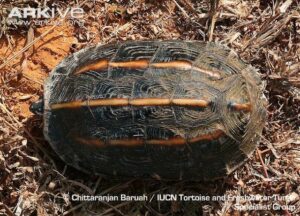
Three-keeled land Tortoise (Melanochelys tricarinata )
This tortoise mainly lives in the Ganges and Brahmaputra drainages of northeastern India.
Tricarinate hill turtle Melanochelys tricarinata is a species of turtle found in India (Assam), Bangladesh and Nepal. Type locality: “Central India (Chaibása)” (Chaibassa, Bihar State, eastern India).
Sea turtle
Sea turtles (superfamily Chelonioidea and Dermochelyidae) are marine reptiles that inhabit all of the world’s oceans except the Arctic.
Olive ridley sea turtle
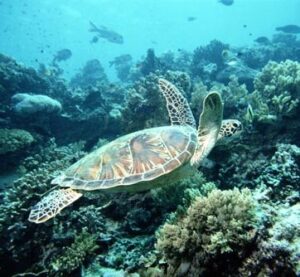
The olive ridley sea turtle (Lepidochelys olivacea), also known as the Pacific ridley, is a species of sea turtle.
Olive ridleys rarely weigh over 50 kilograms. A study in Oaxaca, Mexico reported an adult sample ranging from 25 to 46 kilograms. Adult females weighed an average of 35.45 kg (n=58), while adult males weighed significantly less averaging 33.00 kg (n=17). Hatchlings usually weigh between 12.0 to 23.3 grams.
The olive ridley turtle has a cirumtropical distribution living in tropical and warm waters of the Pacific and India Oceans fromIndia, Arabia, Japan, and Micronesia south to southern Africa, Australia, and New Zealand. In the Atlantic Ocean, it has been observed off the western coast of Africa and the coasts of northern Brazil, Suriname, Guyana, French Guiana, and Venezuela.
Additionally, there have been records of the olive ridley in the Caribbean Sea as far north as Puerto Rico. It is also found in the eastern Pacific Ocean from the Galapagos Islands and Chile north to the Gulf of California, and along the Pacific coast to at least Oregon.
Green Sea Turtle
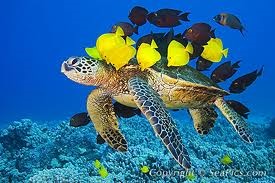
The Green sea turtle (Chelonia mydas), also known as green turtle, black (sea) turtle, or Pacific green turtle, is a large sea turtle of the family Cheloniidae. It is the only species in the genus Chelonia. Its range extends throughout tropical and subtropical seas around the world, with two distinct populations in the Atlantic and Pacific Oceans. Their common name derives from the usually green fat found beneath theirc arapace (upper shell).
The green turtle is large, with a carapace up to 3 feet long. Green turtles weigh up to 350 pounds and their carapace can be many colors, including shades of black, gray, green, brown or yellow. Adult green turtles are the only herbivorous sea turtles. When young, they are carnivorous, but as adults they eat seaweeds and seagrass. They are found in tropical and sub-tropical waters around the world.

guide to freshwater turtles and tortoises of india
Tortoises and Freshwater Turtles of India
Compiled & Shared by- Team, LITD (Livestock Institute of Training & Development)
Image-Courtesy-Google
Reference-On Request.


